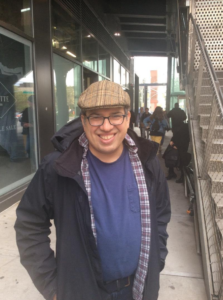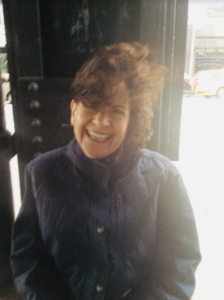Thinkers in Residence spend time on 14th Street over the festival weekend reflecting on 14th Street, patterns of movement, artists, pedestrians, publics, personal reflections, and participation. Their responses take the form of writing, walking, image-making, poetry, or on-the-spot conversations with the public.
And now the observations of Davidson Garrett, Day 2.
Edward Einhorn: “Performance For One”
By Davidson Garrett

I have always shied away from participatory theater through the years. For me, being singled out in the audience and having to banter with an actor on stage—always frightened me into avoiding such theatrical presentations. That being said, it was with a bit of reluctance that I made a reservation for Edward Einhorn’s “Performance For One,” presented by Untitled Theater Company No. 61, for the Art in Odd Places INVISIBLE 2019.
On a blustery Thursday, freezing from the backside of a Nor’easter hitting the New York area, I ventured to the entrance of the Highline Park on West 14th Street, where this play would be performed on the sidewalk underneath the park. Andrea Gallo was the actress who would be featured at the 4:45 pm performance. Approaching the area, with the wind gusting about twenty miles an hour, I saw an empty chair where I would be sitting for the short experience. The Meat Packing District was hectic with pedestrians—who were somewhat indifferent to the artistic happening about to take place.
Ms. Gallo, dressed casually, sat in a chair beneath the former railroad track, and invited me to sit in the empty chair opposite her. Quickly, she began speaking by assuring me this was going to be a comforting adventure, and there should not be any fear or trepidation inside of me. With a melodious voice, and her brunette hair blowing ferociously by the wind, I was told that I could look directly into her eyes, or I could look down at her hands. At first I thought I was having a Marina Abramovic moment, looking into this thespian’s eyes as we sat knee to knee. They were gentle, loving eyes, and we stared at each other for a few seconds as I then glanced down at her hands.
Beginning the performance, the hands were the first focus, with the monologist musing about the intimacy of hands. She spoke liltingly, and asked if I wanted to shake or hold her hand. I did shake her hand, and then I was instructed that words from me were not necessary, and I could enjoy our time together just listening. This was calming, and I immediately felt comfortable seated across from her. All of a sudden, I was not at a performance, but hearing a lot of wisdom pouring forth from the mouth of a stranger. It seemed like we had been friends for a very long time. My apprehension lifted, and I began to enjoy being a part of this theatrical moment.

Continuing speaking about the intimacy of hands, Andrea Gallo revealed details about her father’s hands, which made me think of my own father. With every life situation explored, my mind examined my own feelings, conjuring images about my past and present. As the ten minutes passed, there developed an intimate bond between this audience member and the player. I forgot the actress was saying lines written by Edward Einhorn. I was totally transported into the emotional ideas mentioned, and the connections to my own self.
Toward the end of the monologue, Andrea, my new best friend, said that our time together would be etched inside of me for a long time. Looking into her eyes, I knew she was right. I will think of this special afternoon—when I truly was an audience of one.






